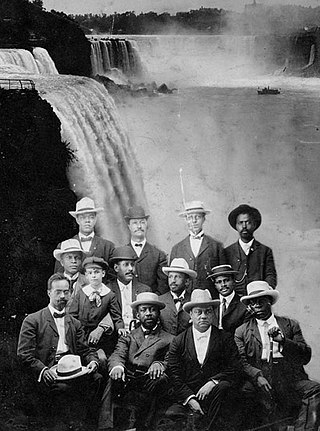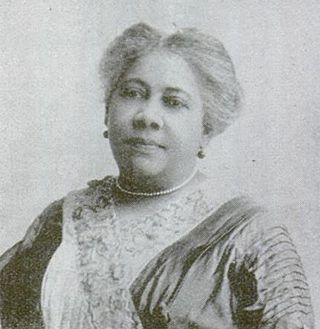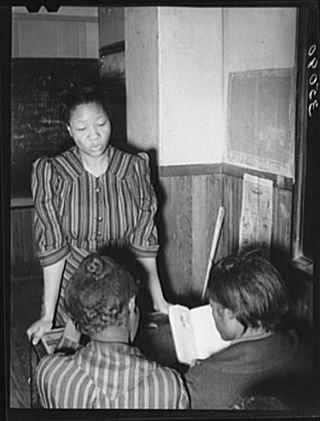
The civil rights movement was a social movement and campaign from 1954 to 1968 in the United States to abolish legalized racial segregation, discrimination, and disenfranchisement in the country. The movement had its origins in the Reconstruction era during the late 19th century and had its modern roots in the 1940s, although the movement made its largest legislative gains in the 1960s after years of direct actions and grassroots protests. The social movement's major nonviolent resistance and civil disobedience campaigns eventually secured new protections in federal law for the civil rights of all Americans.

Asa Philip Randolph was an American labor unionist and civil rights activist. In 1925, he organized and led the Brotherhood of Sleeping Car Porters, the first successful African-American-led labor union. In the early Civil Rights Movement and the Labor Movement, Randolph was a prominent voice. His continuous agitation with the support of fellow labor rights activists against racist labor practices helped lead President Franklin D. Roosevelt to issue Executive Order 8802 in 1941, banning discrimination in the defense industries during World War II. The group then successfully maintained pressure, so that President Harry S. Truman proposed a new Civil Rights Act and issued Executive Orders 9980 and 9981 in 1948, promoting fair employment and anti-discrimination policies in federal government hiring, and ending racial segregation in the armed services.

African-American music is a broad term covering a diverse range of musical genres largely developed by African Americans and their culture. Its origins are in musical forms that developed as a result of the enslavement of African Americans prior to the American Civil War. It has been said that "every genre that is born from America has black roots."

The Niagara Movement (NM) was a civil rights organization founded in 1905 by a group of activists—many of whom were among the vanguard of African-American lawyers in the United States—led by W. E. B. Du Bois and William Monroe Trotter. The Niagara Movement was organized to oppose racial segregation and disenfranchisement. Its members felt "unmanly" the policy of accommodation and conciliation, without voting rights, promoted by Booker T. Washington. It was named for the "mighty current" of change the group wanted to effect and took Niagara Falls as its symbol. The group did not meet in Niagara Falls, New York, but planned its first conference for nearby Buffalo. The Niagara Movement was the immediate predecessor of the NAACP.
The civil rights movement (1896–1954) was a long, primarily nonviolent action to bring full civil rights and equality under the law to all Americans. The era has had a lasting impact on American society – in its tactics, the increased social and legal acceptance of civil rights, and in its exposure of the prevalence and cost of racism.

Mary Burnett Talbert was an American orator, activist, suffragist and reformer. In 2005, Talbert was inducted into the National Women's Hall of Fame.
Wayland Seminary was the Washington, D.C., school of the National Theological Institute. The institute was established beginning in 1865 by the American Baptist Home Mission Society (ABHMS). At first designed primarily for providing education and training for African-American freedmen to enter into the ministry, it expanded its offerings to meet the educational demands of the former enslaved population. Just before the end of the 19th century it was merged with its sister institution, the Richmond Theological Seminary, to form the current Virginia Union University in Richmond.
This is a list of African Americans, also known as Black Americans or Afro-Americans. African Americans are an ethnic group consisting of citizens of the United States mainly descended from various West African and Central African peoples with possible minor additional ancestry from Europe or indigenous Americans and other regions of Africa. As an ethnic group, African Americans are largely the modern-day descendants of West Africans and Central Africans brought to the US from the Trans-Atlantic slave trade who developed a new and distinct cultural identity during their time in the Americas.
The civil rights movement in Omaha, Nebraska, has roots that extend back until at least 1912. With a history of racial tension that starts before the founding of the city, Omaha has been the home of numerous overt efforts related to securing civil rights for African Americans since at least the 1870s.
The Jim Crow laws were state and local laws introduced in the Southern United States in the late 19th and early 20th centuries that enforced racial segregation, "Jim Crow" being a pejorative term for an African American. Such laws remained in force until 1965. Formal and informal segregation policies were present in other areas of the United States as well, even as several states outside the South had banned discrimination in public accommodations and voting. Southern laws were enacted by white-dominated state legislatures to disenfranchise and remove political and economic gains made by African Americans during the Reconstruction era. Such continuing racial segregation was also supported by the successful Lily-white movement.

The National Association for the Advancement of Colored People (NAACP) is a civil rights organization in the United States, formed in 1909 as an interracial endeavor to advance justice for African Americans by a group including W. E. B. Du Bois, Mary White Ovington, Moorfield Storey, Ida B. Wells, Lillian Wald, and Henry Moskowitz. Over the years, leaders of the organization have included Thurgood Marshall and Roy Wilkins.
African-American women began to agitate for political rights in the 1830s, creating the Boston Female Anti-Slavery Society, Philadelphia Female Anti-Slavery Society, and New York Female Anti-Slavery Society. These interracial groups were radical expressions of women's political ideals, and they led directly to voting rights activism before and after the Civil War. Throughout the 19th century, African-American women such as Harriet Forten Purvis, Mary Ann Shadd Cary, and Frances Ellen Watkins Harper worked on two fronts simultaneously: reminding African-American men and white women that Black women needed legal rights, especially the right to vote.

African Americans in Florida or Black Floridians are residents of the state of Florida who are of African ancestry. As of the 2010 U.S. Census, African Americans were 16.6% of the state's population. The African-American presence in the peninsula extends as far back as the early 18th century, when African-American slaves escaped from slavery in Georgia into the swamps of the peninsula. Black slaves were brought to Florida by Spanish conquistadors.
African Americans are the second largest census "race" category in the state of Tennessee after whites, making up 17% of the state's population in 2010. African Americans arrived in the region prior to statehood. They lived both as slaves and as free citizens with restricted rights up to the Civil War.
Charlotte L. Brown (1839–?) was an American educator and civil rights activist who was one of the first to legally challenge racial segregation in the United States when she filed a successful lawsuit against a streetcar company in San Francisco in the 1860s after she was forcibly removed from a segregated streetcar. Brown's legal action and the precedent it created led to additional challenges to segregation in San Francisco and within 30 years, California enacted legislation to make such segregation on streetcars illegal statewide.

African-American teachers educated African Americans and taught each other to read during slavery in the South. People who were enslaved ran small schools in secret, since teaching those enslaved to read was a crime. Meanwhile, in the North, African Americans worked alongside Whites. Many privileged African Americans in the North wanted their children taught with White children, and were pro-integration. The Black middle class preferred segregation. During the post-Reconstruction era African Americans built their own schools so they did not have White control. The Black middle class believed that it could provide quality education for their community. This resulted in the foundation of teaching as a profession for Blacks. Some Black families had multiple individuals who dedicated their lives to teaching. They felt that they could empower their communities. In the late 19th and early 20th centuries, Southern States passed Jim Crow laws to mandate racial segregation in all aspects of society, and prevent Blacks from voting. Racism made it difficult for Black professionals to work in other professions. In 1950, African American teachers made up about half of African-American professionals.

The history of African Americans or Black Philadelphians in the city of Philadelphia, Pennsylvania has been documented in various sources. People of African descent are currently the largest ethnic group in Philadelphia. Estimates in 2010 by the U.S. Census Bureau documented the total number of people living in Philadelphia who identified as Black or African American at 644,287, or 42.2% of the city's total population.
African Americans in San Francisco, California, composed just under 6% of the city's total population as of 2019 U.S. Census Bureau estimates, down from 13.4% in 1970. There are about 55,000 people of full or partial black ancestry living within the city. The community began with workers and entrepreneurs of the California Gold Rush in the 19th century, and in the early-to-mid 20th century, grew to include migrant workers with origins in the Southern United States, who worked as railroad workers or service people at shipyards. In the mid-20th century, the African American community in the Fillmore District earned the neighborhood the nickname the "Harlem of the West," referring to New York City's Harlem neighborhood, which is associated with African American culture.

The history of slavery in Colorado began centuries before Colorado achieved statehood when Spanish colonists of Santa Fe de Nuevo México (1598–1848) enslaved Native Americans, called Genízaros. Southern Colorado was part of the Spanish territory until 1848. Comanche and Utes raided villages of other indigenous people and enslaved them.









